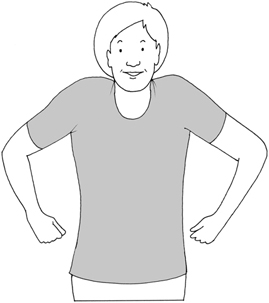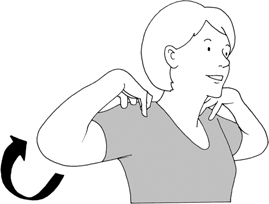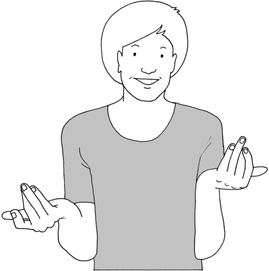
You can adopt a more active lifestyle at any age. Begin by doing what feels comfortable and safe for you, and progress to an appropriate pace for your age and ability. It’s impossible for me to give individual advice regarding appropriate exercise – so use your common sense and take care.
This is the information from the Royal Osteoporosis Society (ROS):
The higher the impact the better for bone strength, at least up to a moderate impact (jogging, hopping, running, low-level jumping). Research shows that moderate-impact exercise is generally safe for most people with osteoporosis, and gives your bones sufficient impact to promote bone strength.
Impact exercise is unlikely to cause a spinal fracture but to be on the safe side, if you have had spinal fractures (or have broken lots of other bones because of osteoporosis) aim for lower-impact exercise (brisk walking, marching). If your spinal fracture didn’t occur during exercise, then building up gradually to a moderate level of impact may be appropriate.
Choose exercises or activities you can manage and then build up the intensity gradually. If you are increasing your exercise levels and you are at all unsteady, do some balance exercises first so you are more likely to maintain steadiness.
The programme of exercises consists of many and varied, simple and easy movements designed specifically to strengthen your body and preserve bone strength. You can incorporate them into your everyday life. You need no more than 30 minutes a day, five days a week – but build up to this slowly, to avoid possible injury or overtiring.
Clear enough space and use furniture and fittings around the house, like tables, chairs, banisters and the kitchen sink, for support. It’s essential to make sure they are strong and secure enough to take your weight. Exercising outdoors in the fresh air can give you that extra boost, but whether in the house or garden, check that the ground surface isn’t wet or slippery. Don’t exercise immediately after meals and keep drinking water near at hand to avoid you becoming dehydrated.
WARM-UP
It’s essential to prepare your body for further exercise and activity by putting your major joints through their natural range of movement, warming up major muscles and raising your pulse. This provides cardiovascular benefits, which boost the heart and circulatory system.
Muscles and joints work most effectively when they are warm, and the less fit you are, the longer your warm-up needs to be.
An average warm-up should take 5–10 minutes. To help you balance and to keep you safe, you can hold onto a chair or position yourself near a wall for support.
So, let’s make a start.
STAND TALL
Check your posture by standing with your feet comfortably apart, and your shoulders back, but down and relaxed. (Don’t poke your head forward.)
Pull in your tummy muscles, tighten your bottom and tuck your tail under. This will tilt your pelvis forward. Your knees should be soft (relaxed).
Try to maintain good posture throughout all the exercises.

neck stretch
This exercise mobilises your neck and releases tension.
Look over your right shoulder, keeping your chin parallel to the floor. Return your head to face forwards, now slowly drop your chin to your chest. Look up, then slowly look over your left shoulder. Repeat, with control, 10 times. Do not roll your head.

Shoulder Shrugs
This exercise mobilises your shoulders and releases tension.
Simply shrug and lift both shoulders up to the ears. Now relax your shoulders and push arms downwards with hands. Repeat 10 times.

Windmills
This exercise mobilises your shoulders and releases tension.
Place your fingertips on your shoulders. Bring your elbows together in front of your chest, then take them up and back, drawing imaginary circles with your elbows and pulling your shoulder blades together.
Do this 10 times clockwise, then 10 times anti-clockwise.


Wrist Circle
This exercise maintains the mobility of your wrists.
Tuck your elbows into your waist. Simply circle your hands, working the wrists first 10 times clockwise, then 10 times anti-clockwise.

Exercises for the legs, hips and lower spine
The following three exercises work directly on the bones in your legs, hips and lower spine, to slow bone loss:
Marching
Moving your joints through their full range of movements helps you to maintain balance, improve posture and prevent muscle injury. It also raises your heart rate. So, let’s up the pace by simply marching on the spot with determination.
Lift your knees up high and swing your opposite arms as you march. Continue for at least 1 minute.

Side Step
Step your left foot out to the side and bring it back to touch your right foot. Repeat 10 times.
Step your right foot out to the side and back to touch the left foot. Repeat 10 times. Swing your arms as you step.


Forward, Back and Clap
Step the right foot to the front and bring the left foot up to join. Lift your arms and clap your hands. Step the right foot back and the left foot back, then clap. Repeat 10 times.
Next, lead with the left foot, bringing the right foot up to join it. As before, repeat 10 times.

Vigorously shake out your hands, legs and feet . . . your body is now warm.
If you have osteoporosis, turn to Chapter 12 for the Osteo Relief exercise programme.
Otherwise, it’s time to work on your upper body, so please turn to the next chapter. Alternatively, do whatever form of moderate physical activity you prefer, such as dancing, brisk walking, hiking or some form of organised sport.